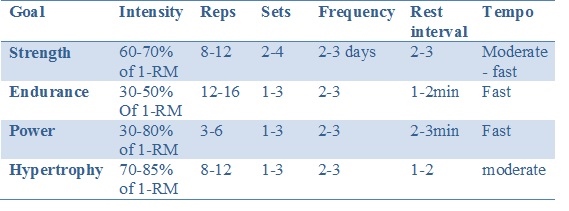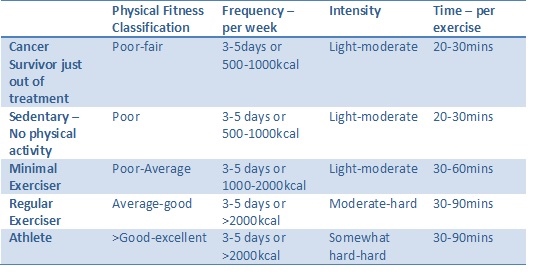Return to Fitness Program
Resistance Training (FITT)
Frequency: The frequency of resistance training is dependent upon the particular individual and format of the program. A program that works every body part every session should be completed 1-3 days a week with a day’s rest between sessions. If patients train too often, their muscles wont be able to work with enough intensity to improve their fitness, and soreness and injury are more likely to result.
Intensity: For resistance training, workload is the primary measure of intensity. You can increase workload by lifting heavier weights. Or you could increase the number of repetitions with the same weight. Finally, you could lift the same weight for the same number of repetitions but decrease the rest time between sets. Guidelines recommended that patients exercise 30-60 minutes of moderate to vigorous physical activity, 50-80% 1 repetition maximum, with a 4-7/10 rating of perceived exertion. Patients should work with weights that they can still maintain proper form while exercising.
Type: Resistance bands could be used as an alternative or perhaps a circuit training session that only incorporates body weight exercises. Patients should enjoy weight-training sessions and should try to work different muscle groups on alternate days; this can be called a split routine.
Time: Exercising too frequently and too intensely hinders the body’s ability to recover and adapt. As a rule of thumb, the harder you train, the more recovery you should allow for. To help maintain ability to do daily activities, patients should exercise for no more than 5 days a week, and participate in 1-4 sets per muscle group.
Guidelines for Resistance Goals and exercise types

How to get Muscle Results You want
Cardiorespiratory Training (FITT)
Frequency: The guidelines for cardiorespiratory training (also called aerobic conditioning) is a minimum of 3-5 sessions per week
Intensity: Heart rate is the primary measure of intensity in aerobic endurance training. Ideally before you start an aerobic training program a target heart rate zone should first be determined. The target heart rate zone is a function of both your fitness level and age. For patients a target heart rate zone of 50-90 percent of their maximum of heart rate is a good place to start, with a 4-7/10 rating of perceived exertion.
Type: the best type of exercise to tax or improve the cardiovascular system should be continuous in nature and make use of large muscle groups. Examples include running, walking, swimming, cycling, aerobics classes
Time: Individuals with lower fitness levels should aim to maintain their heart rate within the target heart rate zone for a minimum of 20-60 minutes (continuously or intermittent). Beyond this point, cancer survivors can run the risk of injuries. In terms of the duration of the program as a whole, research suggests a minimum of 6 weeks is required to see noticeable improvement.
Guidelines for Cardiovascular Exercise:

Flexibility Training (FITT)
Frequency: survivors should practice their flexibility at least 2-3 days per week
Intensity: stretches should be held until there is tension on muscles but not pain
Time: survivors should do 2-4 sets of exercise per muscle group and they should try to hold the pose for at least 10-30 secondspatients should participate in stretching exercises only 15-30 minutes per day
Static stretches to warm up muscles (that should last roughly 20-60 seconds) and individuals should aim to do 3 sets
Type: after warming up, survivors should take part in dynamic stretching (so they can prepare their bodies for exercise) – stretching should not be consumed that it is actually warming up; it is a very important part of warming up but warming up is considered warming up core body temperature. After cool down, survivors should work on static stretching (mostly importantly because it helps gain their flexibility) NOTE: cold muscles do not stretch very well (it is not a good idea to attempt a stretch before your muscles are warm)
**Be cautious when exercising if you have***
• Recently completed surgery (up to 8 weeks after surgery)
• Extreme fatigue or anemia
• Low blood counts of immune cells or platelets
• High fracture risk
Return to Fitness Program
References
(1) Canadian Cancer Society’s Steering Committee on Cancer Statistics. (May 2012). Canadian Cancer Statistics 2012. Toronto, ON: Canadian Cancer Society
(2)Marshal, T. F. (2012). The Effects of Exercise of Percieved Barriers and Benefits of Exercise in Cancer Survivors Post Treatment. Ann Arbor, MI: ProQuest LLC.
(3)Young-McCaughan, S., & Arzola, S. M. (2007, November). Exercise intervention research for patients with cancer on treatment. In Seminars in oncology nursing (Vol. 23, No. 4, pp. 264-274). WB Saunders.
(4)Young-McCaughan, S. (2006). Exercise in the Rehabilitation from Cancer. Medsurg Nursing, 15(6), 384.


